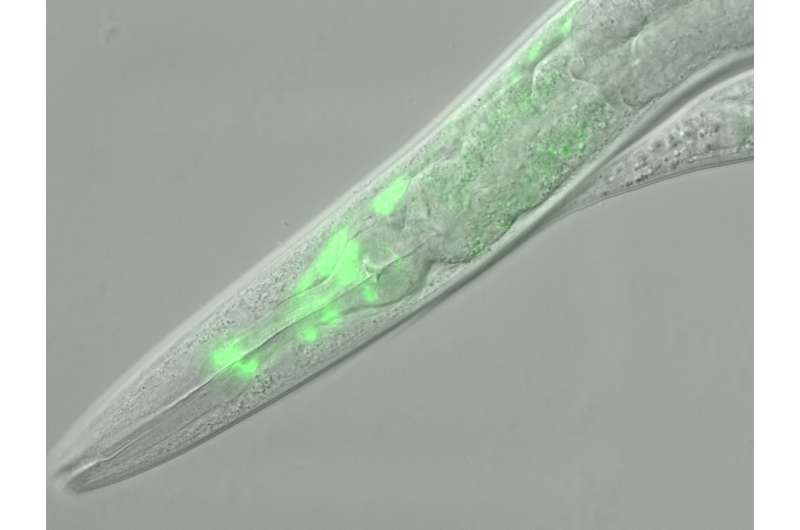What roundworms can teach us about human growth

Human beings and the roundworm C. elegans have more in common than you'd expect. Thanks to a common ancestor more than 700 million years ago humans and roundworms have a similar hormone to drive and regulate growth. By activating or deactivating this hormone scientists can stimulate or stunt the growth of the worms. This is shown by researchers from the Functional Genomics and Proteomics Group at KU Leuven (University of Leuven), Belgium.
Our brain produces hormones that regulate our growth and development. One of them is the thyrotropin-releasing hormone known as TRH. Thanks to TRH, growth-regulating hormones are produced in the thyroid gland and then released into the bloodstream. A shortage of TRH in the uterus or early childhood can lead to impaired development, dwarfism, and brain damage.
KU Leuven scientists have discovered that the brain of the roundworm Caenorhabditis elegans or C. elegans produces a substance that is related to TRH in human beings. "When we modify the DNA of the worms and deactivate the gene for TRH, the worms stay smaller than their healthy counterparts. We can also repair this growth defect by reinserting the gene. Worms in which we add extra TRH, by contrast, are larger. This shows that TRH is essential to normal growth in human beings as well as in C. elegans," biochemist Isabel Beets explains.
This result is surprising because, until recently, scientists believed that TRH only occurred in vertebrates with a thyroid gland, such as fish, birds, and mammals. "C. elegans is the first invertebrate organism in which we discover a related hormone with a similar function. The similarities between the hormones suggest that our growth mechanisms are ancient: they date back at least 700 million years, to the time when there was a common ancestor of roundworms and human beings. This ancestor most likely used an ancestor molecule of TRH to regulate growth."
Children with growth problems are often administered TRH to test whether a shortage of thyroid hormones underlies the problem. "Human TRH stimulates growth by ensuring that thyroid hormones are released into the bloodstream. When this release is insufficient, the patients may be given extra thyroid hormones to treat the growth problems," Beets continues. "But TRH also regulates our growth in ways we don't yet properly understand, for instance through our appetite. Now that the similarities between the growth-regulating hormones of roundworms and human beings are clear, this offers new possibilities for research into these mechanisms."
More information: Elien Van Sinay et al, Evolutionarily conserved TRH neuropeptide pathway regulates growth in, Proceedings of the National Academy of Sciences (2017). DOI: 10.1073/pnas.1617392114
Journal information: Proceedings of the National Academy of Sciences
Provided by KU Leuven


















